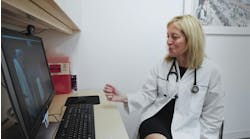Springfield Clinic is Illinois’ second-largest private, multispecialty medical group with more than 675 providers in over 80 medical specialties and subspecialties. The organization’s chief brand and advocacy officer, Zach Kerker, recently spoke with Healthcare Innovation about working with Health Note, a clinical documentation company, on digitizing the patient experience, as the clinic also implements the athenaOne EHR in all locations across the 20 counties it serves in Illinois.
Healthcare Innovation: Your title is chief brand and advocacy officer. How do branding and advocacy come together in your role?
Kerker: It's been a weird journey. I'm actually a sports broadcaster by trade. I worked in television, affiliate sports, and then left to go do a sports web channel here in Springfield, Illinois. I came here as a director of marketing of Springfield Clinic, and built our our marketing department, our communications department and rebranded. Then we built a patient experience department. I think that patient experience is aligned with the marketing side. When we're branding, when we're marketing ourselves, we're telling people what we want them to think about us. The patient experience data is telling us whether what we think we are actually aligns with what the patients think of us. You can’t lose the trust of your patients.
On the advocacy side, we ended up in a big dispute with a major insurance carrier back in mid-2021. It was a very public and sort of ugly experience. We really didn't have anybody on our team from a PR standpoint or a government advocacy standpoint or a community outreach standpoint, who was trying to make sure that we were working with other community stakeholders so that they understood why we were in the position we were in, and working with legislators to make sure that they understood what was happening. That has grown into me advocating at the Legislature on bills touching things like prior authorization and network adequacy.
HCI: What are some things you are working on to improve patient experience?
Kerker: We wanted to create a more modern experience — the same way you go online to make a reservation for a restaurant anytime, and they asked you if you need anything special accommodations. You should be able to schedule an appointment online. Through Health Note, patients can fill in all the pre-registration at their leisure. We wanted to create options that gave patients on-demand opportunity to complete the steps that would allow us to care for them appropriately. And Health Notes has been a tremendous partner in online scheduling and the pre-registration process. You can pay your co-pay before you walk in the door online. It will remember your credit card. These are simple things that you experience in any other retail industry. When we looked at in 114,000 patient surveys, those were always pain points, and now it's the thing that patients say they loved the most. So it was just obvious.
HCI: There are probably several vendors offering this type of solution. What stood out about Health Note to you?
Kerker: Health Note sits at the table with us and tries to help us solve problems rather than saying here's our solution, take it or leave it. They want to be problem solvers with you. We have 90 specialties in our organization with unique processes and workflows and pre-registration processes and forms, so you can't apply a one-size-fits-all approach across all of them.
HCI: Did you start with a pilot in a few clinics and then expand across the whole system?
Kerker: Yes, we're at different degrees of implementation from pilot into full-scale rollout on self-scheduling and pre-registration forms.
HCI: Is it a cultural change for the clinics themselves to implement something where the patients choose their own time for appointments?
Kerker: Yes. They’re used to having total control over that and having their front staff do it. You have to call and wait on a phone. But the pilot allowed us to show the value of it and the volume of patients taking advantage of it. The value-add is self-evident, but it is a huge mind shift in the healthcare space to give up some of that control.
HCI: Health Note has an integration with athenahealth’s EHR and I understand Springfield Clinic is deploying athenaOne now. Did that help?
Kerker: We are in the middle of an athena roll-out. We’re about halfway through it. One of the big selling points for athena is that it really does allow for bolt-on attachments. Because the scope of work of an EHR is so broad, it's very difficult for any EHR to do niche things so well. So the areas that you really want to optimize, you have got to find partners that do that as their primary function. And that's why Health Note is such a good partner on this, because they live and breathe this.
HCI: Are there other patient engagement improvements from athena? Perhaps a better patient portal?
Kerker: No doubt, but the complex thing is figuring out exactly where the patient engagement pieces intersect. We're excited about the patient portal experience. You can schedule appointments through the patient portal in athena. Then the question is, how much do we do of that and how much do we do through Health Note? We feel like we have to create a pathway both for a web-based experience and then also a portal-based experience to accommodate whichever way the patient wants to go.
HCI: Is your team measuring the impact of this automation on the reduction in administrative workload that the clinic staff has to do and does it perhaps free them up to do other things?
Kerker: Yes. What we really found is that it allows us to re-allocate positions to other spots. And certainly, as we're changing EHRs, it's all hands on deck. But here's what I think is the most important thing that it does: When a patient comes in, instead of me looking at my screen and asking you data entry questions, date of birth, reason for visit, etc., those are already completed. When you get here, now I'm making eye contact with you. I'm welcoming you. I'm making small talk with you. I'm asking you what we can do to take care of you until you get back into the exam room. And it creates a more personal experience. So it does create potential for FTE optimization, but the most important thing that it does is it creates a more human experience, which is kind of ironic. You use technology to do all the data entry, but it allows people to engage with one another when they come in, and that's the kind of experience that we wanted to create.


